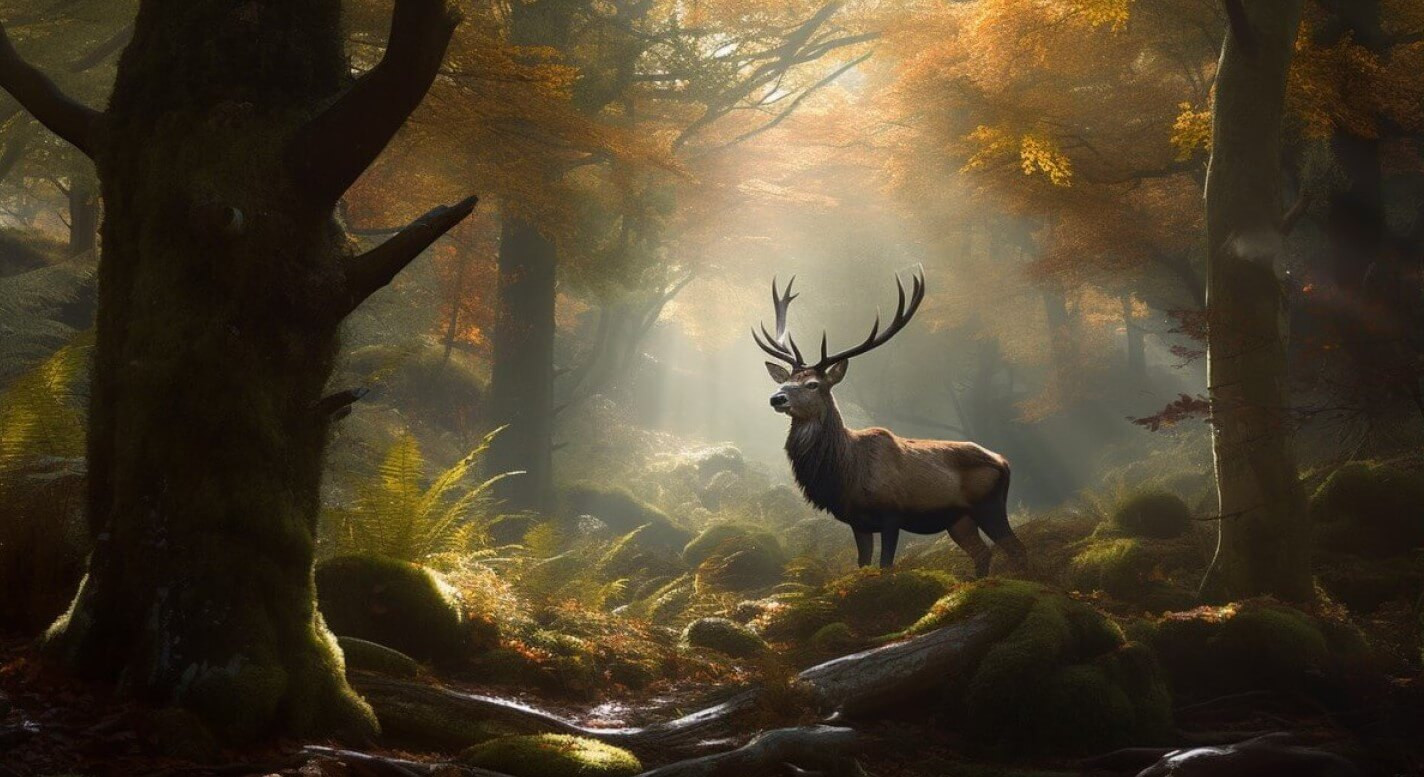Would you prefer to listen to a short podcast discussion about this article? Click on the audio below.
Introduction
If you live in the UK, you’ve probably seen wild deer while out for a walk or drive. These majestic animals are common in the countryside, but what exactly are wild deer, and why are they important to the UK’s ecosystem?
Table of Contents
Some people consider deer to be a valuable addition to the UK’s ecosystem, while others view them as a nuisance that causes damage to crops and woodlands. This article aims to provide an in-depth insight into the world of wild deer in the UK, exploring their biology, behaviour, impact on the environment, population control measures, hunting and conservation efforts, human interactions, and the challenges and opportunities in their management.
What are Wild Deer?
Wild deer are ungulates, or hoofed mammals, that live and breed in the wild. They are an important part of the ecosystem in the UK, providing food for predators like wolves (which are now extinct in the UK) and foxes and helping to control vegetation growth in forests and other areas.

History of Deer in the UK
Wild deer have been present in the UK for thousands of years and are important to the country’s cultural heritage. In the Middle Ages, deer hunting was a popular activity among the nobility, and many of the UK’s forests and parklands were created for deer hunting.
Wild deer are important to the UK’s ecosystem today because they help control vegetation growth, which helps maintain a healthy ecosystem. They are also an important food source for predators and provide opportunities for wildlife watching and outdoor recreation.
The Different Species of Deer That Roam the UK
There are six species of wild deer in the UK, each with unique characteristics and behaviours. Here’s a brief overview of each species:
Red Deer
Red deer are the largest species of wild deer in the UK and are found throughout Scotland and parts of England. They are known for their distinctive red coat and impressive antlers, which are shed and regrown each year.
Fallow Deer
Fallow deer have a distinctive spotted coat and are found throughout the UK, especially in parklands and other managed landscapes. They are smaller than red deer but are still an impressive sight.
Roe Deer
Roe deer are the smallest species of wild deer in the UK and are found throughout the country. They are known for their reddish-brown coat and relatively short, simple antlers.
Sika Deer
Sika deer are native to Asia but were introduced to the UK in the 19th century. They are found primarily in Scotland and parts of England and are known for their dark coat and distinctive white spots.
Muntjac Deer
Muntjac deer are small and elusive and are found primarily in southern England. They are known for their distinctive barking call and are often considered a pest by gardeners and farmers.

Chinese Water Deer
Chinese water deer can be found in the UK. They were introduced to the country in the late 19th century and have since established wild populations in certain areas, particularly in East Anglia.
Understanding the Behaviour of Deer
Learning about their behaviour, feeding habits, and movement patterns is important to fully appreciate and understand wild deer in the UK.
Deer Rutting Season
Rutting season, or the mating season, for wild deer in the UK, typically occurs in autumn. During this time, male deer will compete for the attention of female deer, often engaging in displays of dominance and aggression.
Deer Social Structure
Deer in the UK typically live in small social groups led by a dominant male known as a stag. Female deer, or hinds, will typically gather in these groups during the mating season.
Deer Feeding Habits and Diet
Wild deer in the UK are herbivores and primarily feed on grasses, leaves, and other vegetation. They may also feed on crops, which can cause problems for farmers and gardeners.
Movement and Migration of Wild Deer
Wild deer in the UK are known for their ability to move long distances, especially during the mating season. Some deer may also migrate to different areas in search of food or to avoid predators.
The Impact of Deer on the Environment and Agriculture
While wild deer are an important part of the UK’s ecosystem, they can also significantly impact the environment and agriculture.
Positive and Negative Effects of Deer on the Environment
Wild deer can help to control vegetation growth and provide food for predators, but they can also damage trees and other vegetation, especially during the mating season. Additionally, deer droppings can contribute to the spread of harmful bacteria.
Damage to Agricultural Crops and Woodland by Deer
Wild deer can cause significant damage to agricultural crops and woodland, which can be costly for farmers and landowners. They may also be involved in road accidents, which can cause damage to vehicles and present a safety hazard.
The Cost of Deer Damage and Management
The cost of deer damage and management can be significant, with estimates suggesting that it costs millions of pounds each year. This includes the cost of repairing damage caused by deer, as well as the cost of implementing management strategies such as culling and fencing.
Population Control Measures for Deer
Culling and Hunting of Wild Deer
Culling and hunting are the most common and effective methods used for controlling the population of wild deer in the UK. Culling, which involves killing deer, is often done by professional marksmen who operate under strict guidelines to ensure that it is humane and safe. Hunting, on the other hand, is the act of pursuing deer to kill them for sport or food. Both methods aim to manage the deer population and minimize the damage they cause to crops, woodlands, and other habitats.
Deer Fencing and Other Physical Barriers
Another way to control the population of wild deer in the UK is to use deer fencing and other physical barriers. These measures can be effective in protecting gardens, crops, and other areas from deer damage. The fences are usually constructed of high-tensile wire or mesh and can be up to 2.5 meters high. Other physical barriers include trenches and hedges.
Deer Repellents and Other Non-Lethal Control Techniques
Besides culling, hunting, and physical barriers, there are non-lethal methods of controlling the population of wild deer in the UK. These include repellents, scare tactics, and relocation. Deer repellents are usually made of natural substances that deer find unpleasant or have an aversive effect on them. Scare tactics involve using loud noises, flashing lights, or dogs to scare the deer away. Relocation is the process of capturing and moving deer to a different location, usually a more suitable habitat.
Hunting and Conservation of Deer
History of Deer Hunting in the UK
Deer hunting has a long history in the UK, dating back to the Middle Ages when it was a popular pastime for the nobility. Deer hunting continued to be a popular sport in the following centuries, and by the mid-19th century, deer populations were declining due to overhunting and habitat loss.
Legal Framework for Deer Hunting
Today, deer hunting is regulated by the Deer Act 1991, which sets out rules and regulations governing deer hunting, culling, and management. The act aims to ensure that deer populations are managed sustainably and humanely.
Conservation Efforts
Conservation efforts for wild deer in the UK include habitat protection, population surveys, and research. Many conservation organizations work to protect deer habitats and raise awareness of the importance of deer in the ecosystem.
Human Interaction with Wild Deer
Deer Watching and Photography
Deer watching and photography have become increasingly popular in recent years, and many nature reserves and parks offer opportunities to see wild deer up close. Watching deer in their natural habitat can be a rewarding and enjoyable experience, but it is important to respect their space and not disturb them.
Deer-Vehicle Collisions
Deer-vehicle collisions are a common problem in the UK, particularly in rural areas. These collisions can be dangerous and cause damage to vehicles and injuries to passengers. Drivers are advised to be vigilant and reduce their speed when driving in areas where wild deer are known to be present.
Deer Attacks on Humans
Deer attacks on humans are rare in the UK, but they can occur, particularly during the mating season when stags can become aggressive. It is important to keep a safe distance from wild deer and never approach or touch them.
Future of The Deer: Challenges and Opportunities
Deer Management Policies and Regulations
The future of wild deer in the UK depends on effective management policies and regulations that balance the needs of deer with those of other species and habitats. It is important to manage populations sustainably and humanely to avoid overpopulation and damage to habitats.
Climate Change and Its Effects on Wild Deer
Climate change is likely to significantly impact wild deer populations in the UK, particularly in terms of habitat loss and changes in food availability. It will be important to monitor these changes and adjust management policies accordingly.
Opportunities for Sustainable Deer Management and Use
There are opportunities for sustainable wild deer management and use in the UK, including hunting for sport and food and the use of deer products such as antler velvet and venison. It will be important to manage these opportunities carefully to ensure that they are sustainable and do not harm wild deer populations or their habitats.
In conclusion, wild deer in the UK are an essential part of the country’s natural landscape, and their proper management ensures their continued existence for future generations. While there are challenges to overcome, such as population control measures and human interactions, there are also opportunities to develop sustainable practices for the management of wild deer in the UK. With proper conservation efforts and responsible use, deer can continue to thrive in the UK while minimizing their environmental and agricultural impact.
FAQ
1. Are there any laws that protect deer?
Yes, wild deer in the UK are protected by various laws, including the Wildlife and Countryside Act 1981 and the Deer Act 1991. These laws are in place to regulate deer hunting and management and to protect deer from poaching and other illegal activities.
2. Can I feed wild deer?
Feeding wild deer in the UK is not recommended as it can lead to health problems and unnatural behaviours. Feeding wild deer in some areas is also illegal, and doing so can result in a fine.
3. How can I prevent deer from damaging my property or crops?
Several ways to prevent deer from damaging your property or crops include installing deer fencing, using deer repellents or other non-lethal control measures, and implementing sustainable hunting and culling programs.
4. How can I observe wild deer in the UK without disturbing them?
Most wild deer in the UK are wary of humans, so it is essential to avoid making any sudden movements or loud noises that could startle them. The best way to observe wild deer is by using binoculars or a camera from a safe distance, without approaching or interacting with them and obeying any signs or guidance in the area.
Check out the British Deer Society for more information
If you require any assistance with this article, please do not hesitate to Contact Us

















